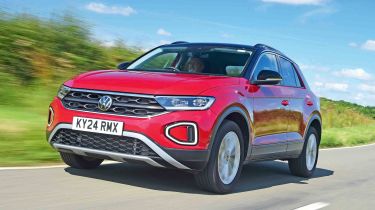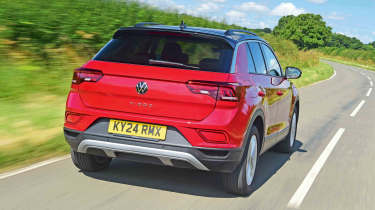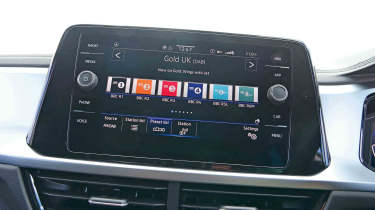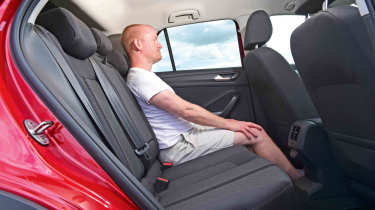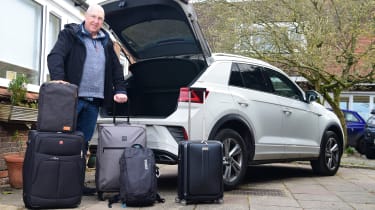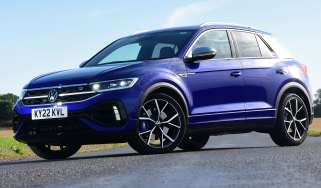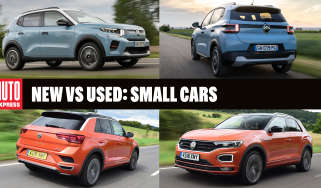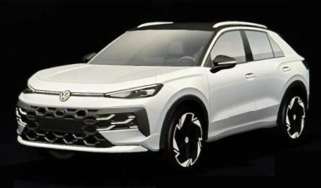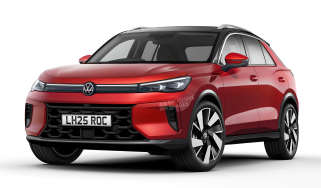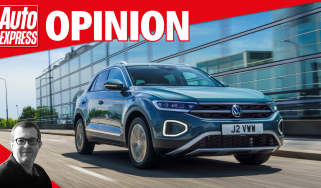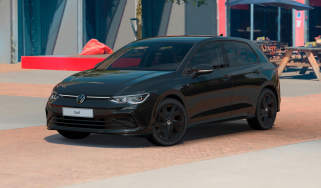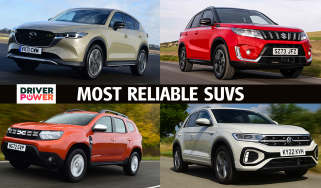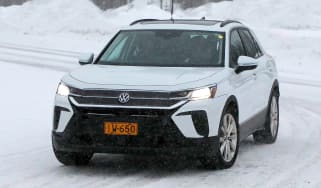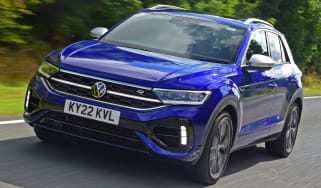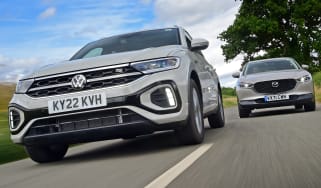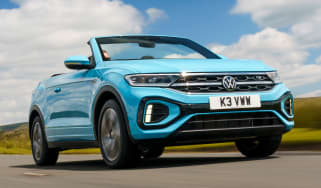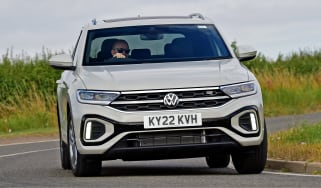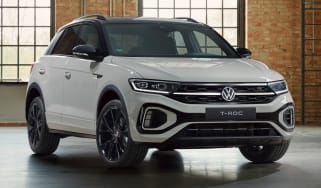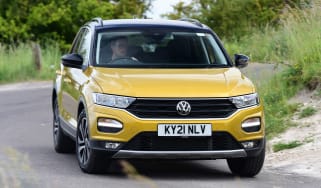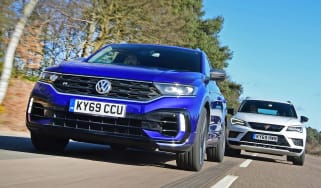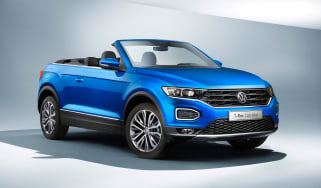Volkswagen T-Roc review
The Volkswagen T-Roc is practical, good to drive, and has a much-improved cabin. It can be pricey, though

The Volkswagen T-Roc was a relative latecomer to the compact SUV segment, but the Golf-sized SUV is a strong contender in this hotly contested class, and it is a sales hit for VW. Best of all, it’s great to drive with spirited engines and a chassis that blends control with a fair degree of comfort.
There’s enough passenger and luggage space for most small SUV buyers’ needs, plus plenty of hi-tech connectivity, autonomous driving and safety kit. Our previous bugbear with the T-Roc's interior quality has been somewhat addressed with a mid-life facelift, which is just as well, given there are more affordable rivals.
About the Volkswagen T-Roc
The Volkswagen T-Roc arrived in 2017 as an SUV-style spin-off from the best-selling VW Golf. Like many crossover-type vehicles, the T-Roc is blessed with off-road style chunky design cues, but the reality is that it’s configured to be easy to drive on tarmac, to be practical and affordable to run, and not to look like a boring old family hatchback.
Like its plentiful rivals, the T-Roc is designed to tap into the booming market for stylish yet family-friendly SUVs, while also bringing a younger audience to the VW brand. Yet behind the racier image, the T-Roc shares much of its technology and engineering with its hatchback Golf sibling and is all the better for it. You pay more for being fashionable because the T-Roc starts at more than the entry-level Golf, but some are willing to pay a premium for a vehicle that’s a little taller.
Used - available now

2022 Volkswagen
T-Roc
17,037 milesManualPetrol1.0L
Cash £17,197
2022 Volkswagen
T-Roc
27,710 milesManualPetrol1.5L
Cash £19,597
2021 Volkswagen
T-Roc
20,709 milesManualPetrol1.5L
Cash £17,495
2025 Volkswagen
T-Roc
21,558 milesAutomaticPetrol2.0L
Cash £27,268The T-Roc comes with a broader range of engine options than the Golf; there’s an entry-level 113bhp 1.0-litre TSI version, a pair of economical diesel engines in 113bhp and 148bhp forms (the latter with optional four-wheel drive), and the high-performance T-Roc R rounding out the range - the latter boasting 296bhp and 4MOTION all-wheel drive for impressive grip. Rounding out the petrol side of things is our preferred 149bhp 1.5-litre and a 187bhp 2.0-litre, the latter comes exclusively with four-wheel drive.
Both the 1.0 and 1.5-litre petrol engines, plus the lower-power diesel come as standard with a six-speed manual, while the 1.5 can be optioned with the same seven-speed DSG automatic that the more potent diesel, 2.0-litre petrol, and range-topping R come with as standard.
How much does the Volkswagen T-Roc cost?
As the T-Roc is based on the Golf, it slots into the VW crossover range between the larger Volkswagen Tiguan and the recently introduced Volkswagen T-Cross – alongside the Volkswagen Taigo coupe-SUV, which joined the range in 2021. Prices start from around £28,500 for the entry-level Life trim and climb to almost £44,500 for the hot R Black Edition version.
Engines, performance and drive
The Volkswagen T-Roc was originally aimed as the brand’s push to get more emotion into its range, but we feel it’s better thought of as a supremely competent all-rounder that specialises more in refinement and comfort, than being one of the more fun small SUVs from behind the wheel.
It starts with the steering, which is light enough at low speeds to make manoeuvring through traffic or parking in a tight multi story a doddle. It doesn’t give much in the way of communication at higher speeds and doesn’t have the sharp responses of a Mazda CX-30, but it is ultimately precise enough for you to feel confident threading it along a twisty B road.
You can carry some speed down a country road because grip levels are strong, and when you do encounter the bends and accidentally go in a little too hot, you’ll feel VW’s electronic diff lock start to kick in by gently braking the inside wheel to help tuck the car’s nose into the turn.
Where the T-Roc impresses most is with its refined motorway manners, where the occasional sharp intrusion from bumps at low speeds (especially with the larger wheel sizes) settles down, leaving a feeling of composure that’s not unlike the VW Golf upon which the T-Roc is based.
Style trim and above can be specified with dynamic chassis control, a system that allows you to adjust ride comfort for over £1000. Its firmest Sport setting can leave you wincing a little over the worst jolts in the road, while a Comfort mode that comes close to achieving the best of all worlds, providing a pliant ride that still keeps you in touch with the state of the surface you’re rolling over. However, the standard suspension set up on the smaller wheel sizes provides a decent enough ride anyway that we don’t think this expensive option is necessary.
There’s a little wind noise over the large door mirrors at speed, but that’s only noticeable because other background noise, such as road and engine noise, is kept at bay so well.
The high-performance R and R Black Edition versions are four-wheel drive cross-country weapons with their own chassis tuning, and you can read about those versions separately in our dedicated VW T-Roc R road test review.
0-62mph acceleration and top speed
The entry-level 113bhp 1.0-litre petrol allows the VW T-Roc to feel sprightly enough in town, with a 0-62mph time of 10.1 seconds giving you enough performance to keep up with traffic and handle the occasional out-of-town jaunt. We prefer the brawnier 148bhp 1.5-litre petrol with its swifter 8.8-second acceleration time because it’s more flexible and doesn’t cost that much more to run. However, get it with the standard six-speed manual because the seven-speed DSG can be a touch laggy when setting off.
The 187bhp 2.0-litre petrol offers a warm hatch-rivalling 7.2 second 0-62 dash, while the hot 296bhp VW T-Roc R drops this time even further to 4.9 seconds.
In contrast, the 113bhp 2.0 TDI diesel takes a leisurely 10.7 seconds to reach 62mph, but its stout 300Nm of torque should make it a relaxing drive without the need to change gear much. The 148bhp version of this engine is quicker at 8.8 seconds and will have no trouble lugging a fully loaded T-Roc with passengers and luggage up to motorway speeds.
MPG, CO2 and running costs
At the entry point to the Volkswagen T-Roc range, the 113bhp 1.0 TSI petrol engine manages a combined economy figure of 49.7mpg. Remarkably, our favourite 1.5 TSI engine isn’t far behind this at 47.3mpg, helped by its clever cylinder deactivation technology that cuts fuel consumption at a cruise. Add the DSG auto to this engine, and efficiency reduces slightly to 46.8mpg, which is still better than the 187bhp 2.0 TSI 4Motion petrol, which returns a maximum of 38.7mpg. Finally, the 296bhp T-Roc R manages only 33.2mpg, but that’s to be expected from a car designed for performance rather than low-running costs.
The 113bhp 2.0 TDI returns 58.9mpg, while the 148bhp TDI manages 56.5mpg in front-wheel drive form, or 50.6mpg when equipped with 4MOTION four-wheel drive.
Tax
The CO2 emissions for the VW T-Roc range goes from 126g/km for the 113bhp 2.0 TDI diesel, up to 196g/km for the range-topping R model. Our recommended 1.5-litre petrol emits 136g/km, putting it in a 32 per cent Benefit-in-Kind (BiK) tax band, so company car drivers might want to consider one of the all-electric competitors to the T-Roc, because doing so will save you a significant amount of money.
Insurance groups
Insurance groups range from 18 for the 1.0 TSI Life to group 33 for the high-performance R model. The 113bhp 2.0-litre TDI diesel Life version is in group 18, with the top-spec 148bhp R-Line oil burner in group 26.
Depreciation
According to our experts, the VW T-Roc performs a little better than the class average when it comes to depreciation, retaining between 47 to 55 per cent of its resale value after three years or 36,000 miles. That’s on par with the Nissan Juke (also 47 to 55 per cent) and similar to the Renault Captur (52 to 55 per cent).
The high-performance R version will still be worth 53 per cent of its original value after the same period.
To get an accurate valuation for a specific model, check out our free car valuation tool...
Interior, design and technology
While many rivals to the Volkswagen T-Roc only come in a small SUV bodystyle, the T-Roc is also available as a four-seater convertible. Some might consider the latter a little mad, but at least that versions offers a reasonable amount of practicality as far as convertibles go, even if it isn’t the most rational version of T-Roc available.
The T-Roc sits on the same MQB platform that supports so many other VW Group cars, there’s a whole host of the very latest tech features – whether it’s connectivity or driver assistance – all controlled through the touchscreen.
With the sportier Volkswagen Taigo coupe-SUV joining the range in 2021, the T-Roc was facelifted in 2022 to keep it fresh alongside its new sibling. This introduced tweaks to the T-Roc's lighting; all models now include LED headlamps, with Black Edition and R Black Edition versions gaining a thin light strip that runs through the middle of the grille - as you'll find on the Volkswagen Polo and Volkswagen Golf. Scrolling indicators are featured at the rear, while Volkswagen has also brought in fresh wheel designs and additional paint colours. Interior quality is noticeably improved over the previous model, with softer plastics in use, too.
An eight-inch 'floating' style touchscreen controls the infotainment system, while Style variants and above come with VW's 10.25-inch digital dashboard display, which is a nearly £400 option on the entry-level Life and Match trim models.
Volkswagen has seen fit to dispense with physical switches for the climate control function and introduce touch-sensitive buttons. We're not a fan of the change because they simply don't work as well as before, being fiddly and distracting to use on the move.
Sat-nav, stereo and infotainment
The eight-inch infotainment touchscreen has wireless Apple CarPlay and Android Auto, and a pair of USB-C ports. Integrated sat-nav is standard with Style models and above, although we’d suggest you save your money and utilise an app-based navigation program from a smartphone and make use of the standard wireless charging pad.
The touchscreen is responsive and easy to use, but it’s been rather unceremoniously plonked on the dash rather than seamlessly integrated like earlier models. The standard eight-inch digital instrument cluster is useful. It can be customised to a certain degree to provide plenty of trip information. Still, the optional 10.25-inch Digital Cockpit Pro (standard from Style trim and above) provides a greater amount of customisation. It can be configured to show navigation information if you utilise the standard sat-nav on higher trim levels.
VW’s Discover Media system is standard on Style trim and above but isn’t the most feature-laden option in the T-Roc range. For that, you need to step up to the Discover Pro system, which costs an extra £1,120. Most buyers will find the standard system absolutely fine – and in some ways better.
This is because the screen is surrounded by touch-sensitive shortcuts for all the key functions, plus two physical dials – one for the volume, and another for zooming in and out on the map screen. Loading times, especially when route planning, are impressively quick, and when we tested the T-Roc against a Mazda CX-30, we found the Volkswagen’s map screen showed the route in a little more detail than the Mazda.
The standard 6-speaker sound system has decent sound quality, but you can upgrade it to a 300-watt Beats audio sound system if you value your music.
Practicality, comfort and boot space
The Volkswagen T-Roc does the family stuff as well as a VW Golf, just with slightly raised seating positions all around. A six-foot tall passenger can sit behind a similarly tall driver in comfort.
There’s decent width across the back seats, too, so seating five inside for a short drive isn’t too much of a struggle. The T-Roc boasts doors that open reasonably wide, and a higher seating position than in a standard hatch, making getting in and out or fitting a child seat easier. The view out is good for those in the back, too.
If you’re in the front, you’ll have no complaints about space or comfort, with multi-adjustable front seats and steering wheel, plus standard lumbar adjustment for the perfect driving position. With the T-Roc’s fairly conventional crossover shape, visibility out of the front, rear and side windows is absolutely fine from the driver’s seat, while the chunky C-pillars don’t create as much of a blind spot as, say, an Audi Q2.
One of the highlights of the T-Roc Cabriolet is that wind noise and buffeting aren’t too much of an issue with the roof down, even at higher speeds. With the top lowered – which takes just nine seconds and can be done at speeds of up to 19mph – and the windows up, you can enjoy the sunshine without feeling too windswept.
Size
It takes up about the same space on the road as a Golf, but there’s more space inside the T-Roc, and the view out is better. Against the tape measure, the T-Roc is 4,234mm long, making it 252mm shorter than the Volkswagen Tiguan – the next model up in Volkswagen’s SUV line-up. The T-Roc is slightly shorter than a Golf, though only by a whisker. With a width of 1,819mm and a height of 1,573mm, the T-Roc is both wider and taller than the hatchback upon which it is based.
Leg room, head room & passenger space
Inside, there’s plenty of space for four people – five can fit for shorter trips – with decent rear head and legroom even for taller adults sitting in the back behind similarly-sized people in the front. The SUV proportions mean there’s no problem with headroom either.
Like most small SUVs, you get ISOFIX child seat mounting points fitted to the outer positions of the rear seats. Those points are hidden behind some easily removed plastic covers – just make sure to store said covers somewhere safe.
Boot space
The boot offers 445 litres of luggage space, considerably more than the 380 litres in a Golf. It’s a nice square shape with a floor that’s nearly level with the bumper when the standard adjustable height boot floor in its raised position, making loading heavy loads easy. The rear seats fold easily in a 60:40 split to reveal a useful 1,290 litres of overall capacity.
Those looking to maximise practicality should avoid the 4MOTION four-wheel drive models. Adding the all-wheel-drive setup eats into boot space, resulting in a shallow loading area of just 392 litres in size (1,237 litres with seats folded).
The Cabriolet has a 280-litre boot capacity, with enough space for shopping and everyday use, but a normal T-Roc is much more practical for things like buggies, bikes and holiday bags. The small opening limits what you can get in the cabrio, but you can fold the rear bench to open up space behind the front seats.
Towing
The 113bhp 1.0-litre petrol T-Roc is rated to tow up to 1,300kg, while the similarly powerful diesel has a maximum towing limit of 1,500kg, as does the 1.5-litre petrol. For maximum towing capacity, look towards either the 2.0-litre petrol or 148bhp diesel, because these versions of T-Roc can pull up to 1,700kg. Go for four-wheel drive for better traction on wet grass.
Reliability and safety
The Volkswagen T-Roc gets a welcome list of standard safety kit, while you can really go to town with some safety options that used to be the preserve of bigger, far more expensive models.
Autonomous emergency braking features, as does adaptive cruise control, speed limit recognition and a driver fatigue warning. These are fitted as standard across the UK line-up, while lane keep assist is included by default, too.
Loads of other safety and assistance features are found on the options list. A rear-view camera, blind spot monitoring with a lane changing system, semi-autonomous traffic jam assist, self parking assist, and automatic high beam headlights are also available.
The T-Roc was tested by Euro NCAP in 2017, and earned a five-star safety rating. However, the tests have become much more stringent over the years, and so that old score is no longer valid, which is a shame considering the more affordable SEAT Arona was put through the updated 2022 test, and has managed to keep its five-star rating.
In our latest 2024 Driver Power survey, Volkswagen has once again slipped down the rankings, from 27th place (out of 32) in 2023, to 29th out of 32 manufacturers in 2024. The T-Roc came in 29th spot on a 50-car list in the best cars to own poll, coming ahead of the Vauxhall Mokka, but well behind the 10th place Ford Puma.
Warranty
As with the rest of the VW range, the T-Roc has a warranty that lasts for three years or 60,000 miles, whichever comes first. That’s pretty average by industry standards. An extended warranty is offered at additional cost, which can take cover up to five years and 90,000 miles.
There’s also a three-year paintwork warranty and 12 years of cover against corrosion from the inside out.
Servicing
Buyers can choose between Volkswagen’s fixed or flexible service packages. The former is an annual service or every 9,300 miles that’s recommended for lower-mileage cars. Those using their T-Roc for daily trips of over 25 miles will need the flexible service package because it extends the service intervals up to 18,600 miles or every two years.
Fixed-price servicing is available from Volkswagen dealers, but the firm doesn’t have a reputation for offering the sort of low-cost, all-in service package that many rival manufacturers do, so costs here could be higher than for some competitors.
Volkswagen T-Roc Alternatives
The T-Roc has a variety of rivals, including the Audi Q2 (which shares running gear with the T-Roc). There are also hybrid alternatives to consider, such as the Toyota C-HR and Honda HR-V, as well as premium alternatives, such as the BMW X1, BMW X2, Lexus UX, MINI Countryman, Mercedes GLA and lower spec versions of the Volvo XC40.
In 2020, the range was extended to include the VW T-Roc Cabriolet to compete with the previous generation Range Rover Evoque Convertible. Since the demise of that rival, the T-Roc Cabriolet is the only new drop-top SUV of its type around, making it the ‘must-have’ choice for fans of such things.
Volkswagen T-Roc R-Line: long-term test
Our Products editor, Kim Adams, spent six months behind the wheel of a 1.5 TSI DSG R-Line, and he had mixed feelings about it. The T-Roc proved to be an efficient small SUV, managing an average of 43mpg over 3,000 miles, it had a comfortable driving position, and the infotainment system worked well for him.
However, Kim didn’t find a setting in the expensive adaptive suspension system that he liked; the adaptive cruise control system was overly cautious at higher speeds, and the DSG automatic gearbox wasn’t the smoothest at low speeds when parking. You can read the full long term test here...
Frequently Asked Questions
A strong contender in the compact SUV segment, the Volkswagen T-Roc is stylish, practical, and comfortable to drive.

